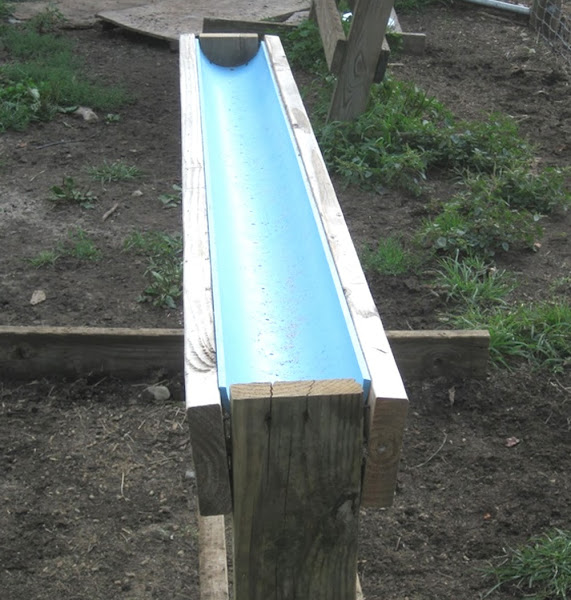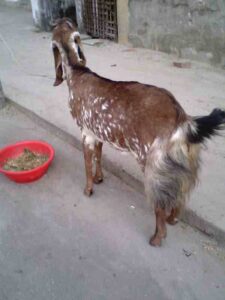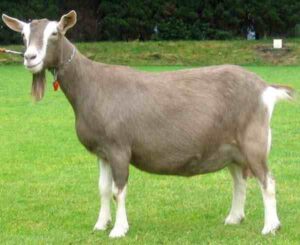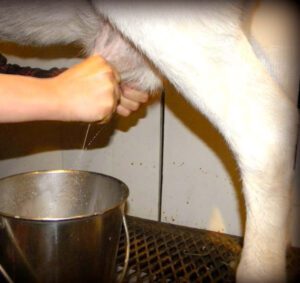For raising goats, you will need various types of feeders for feeding your goats. You can use your home used, recycled or inexpensive materials for making cheap homemade goat feeders. Goats are very curious, intelligent and hardy animal.
So their feeders or anything else which you put inside their area, needs to be as strong and durable as possible. Because they can push, beat up and in many cases destroy the feeders or other materials.
Even, sometimes your goats can also destroy the best designed commercial feeders and other equipment.
So their feeders must have to be strong enough. You can easily make homemade goat feeders by your own, using some inexpensive or recycled materials. This will also reduce your additional farm setup costs.
How to Make Feeders For Goat at Home
Here we are describing the process of making various types of cheap homemade goat feeders and the required materials for this process.
Required Materials
Required materials for making cheap homemade goat feeders depend on the type of feeders. Usually goats need grain, hay and minerals feeders. Depending on the type of feeders, find out suitable scrap materials.
Materials for making homemade goat feeders may include chain, nails, cement, PVC primer, different pieces of dimensional lumber and plywood, screws, PVC pipes with different widths etc. Various types of wooden pallets are very useful for making feeders quickly and easily.
Basic tools for making homemade feeders include drills, saws, a tape measure and hammers.
If you don’t have any materials, then you can check any of your local construction company for excess materials left over from a construction project or check any of your local resale stores.

This types of construction company and local resale stores sell materials at a discount. And sometimes the construction companies give away the excess materials for free (if you are lucky, you can get some free materials).
Hay Feeder
In case of hay feeders, it requires openings. Make the openings small enough that the goats do not get their heads stuck, but large enough for the goats to access the hay. For making hay feeders for a few number of goats, use 2-by-4 board piece.
Put the boards together and make a crate with spaced slats. In case of larger herds, goats require a lot of hay. So you have to make larger sized hay feeders.
You can use a simple cube made from five wooden pallets screwed together. Attach a piece of plywood to the top with hinges for covering the top to keep rain water out of the hay.
Loose Mineral Feeder
For supplementing your goat’s diet, you have to provide them free-fed loose minerals along with their regular foods. PVC pipes works best for this purpose.
You can make a durable mineral feeder with PVC pipe through a few simple steps. For making a loose mineral feeder with PVC pipe, you will need 4 inch PVC pipe along with one 45-degree elbow connector, a female adapter, an end cap and a male threaded cap.
You will also need cement and PVC primer, to seal the feeder. Apply the primer to the top opening in the 45-degree elbow connector and to one end of the PVC pipe.
Allow the primer for a few minutes to sit perfectly. Immediately push the pipe into the connector after applying a thin layer of the cement to both sections.
At this point, you have a long pipe with the opening of the elbow connector (facing upward like the letter J). Do this same process again with the other end of the connector and the female adapter. For closing the bottom, screw in the male cap.
Before proceeding, allow the feeder to sit for at least one day (24 hours). For hanging the feeder, drill holes in the PVC and attach chain or rope to tie. You can also drill the feeder directly onto any walls in the goat shelter.
After successfully fitting the feeder, fill it with loose minerals at the top and close with the end cap. And finally you are done. 🙂
Trough Feeder
Trough feeders are very suitable for serving grain or goat pellets to your goats. Usually the 4 inch diameter PVC is used for this purpose.
And it creates a wide enough trough for the goats. Cut the PVC to length, according to your desired trough length.
Split the PVC length in half, and create two half-moon pieces. Place a piece of 2-inch treated lumber at one end of the trough. Trace the shape of the curve onto the wood.
After that, cut two pieces of wood to this shape for creating the end caps of the trough. Place the wood pieces inside the PVC perfectly and secure it with wood screws.
It will be better if you screw an eyebolt into the top of each piece of wood. After that, attach a chain to each piece for hanging the trough. That’s it. You are done.
Interesting Facts about Homemade Goat Feeders
Homemade goat feeders are an excellent option for budget-conscious farmers who want to make the most out of their resources. They are affordable, easy to construct, and customizable to suit your specific needs.

Furthermore, they are environmentally friendly, low maintenance, and can be used to provide additional enrichment for your goats. Here we are trying to list some interesting facts about homemade goat feeders.
- Homemade goat feeders are made from readily available materials such as old barrels, wooden pallets, and PVC pipes. This means that they are affordable and easy to construct.
- Barrel feeders are a popular type of homemade goat feeder. They are made by cutting a barrel in half and attaching legs to the bottom of each half. The barrel halves are then filled with hay or grain.
- Wooden pallets can also be repurposed into goat feeders. The pallets are dismantled, and the wood is used to construct a simple frame. The frame is then lined with chicken wire, and hay or grain is placed inside.
- PVC pipe feeders are another popular type of homemade goat feeder. The pipes are cut to size and attached to a wooden base. The top of the pipes is capped, and hay or grain is placed inside.
- Homemade goat feeders can be customized to suit your specific needs. For example, if you have multiple goats, you can construct a larger feeder.
- Homemade goat feeders are easy to clean. They can be hosed down or wiped clean with a damp cloth.
- Homemade goat feeders are portable. You can move them around your property to ensure your goats have access to fresh feed.
- Homemade goat feeders can be designed to prevent wastage. For example, if you construct a feeder with a lip, it will prevent the goats from knocking the feed out onto the ground.
- One of the advantages of homemade goat feeders is that they can be constructed to suit your space requirements. If you have limited space in your barn or yard, you can construct a feeder that is compact and easy to store.
- Homemade goat feeders are environmentally friendly. By repurposing old materials, you are reducing waste and minimizing your carbon footprint.
- Another advantage of homemade goat feeders is that they can be constructed to suit the size of your goats. If you have larger goats, you can construct a larger feeder, while smaller goats will require a smaller feeder.
- Homemade goat feeders can be designed to prevent contamination. For example, if you construct a feeder with a lid, it will prevent debris and dirt from getting into the feed.
- Homemade goat feeders can be constructed to be sturdy and durable. By using strong materials and proper construction techniques, your feeder will last for years.
- Homemade goat feeders can be painted or decorated to match your existing barn or yard decor. This means that they can add to the aesthetic appeal of your property.
- Homemade goat feeders can be made from recycled materials such as old tires or metal drums. By repurposing these materials, you are reducing waste and minimizing your impact on the environment.
- Homemade goat feeders are low maintenance. They require minimal upkeep, and any necessary repairs can be made quickly and easily.
- Homemade goat feeders can be constructed using basic tools such as a saw, drill, and hammer. This means that even novice DIY enthusiasts can construct them.
- Homemade goat feeders can be used for other animals such as sheep, miniature horses, and donkeys. By adjusting the size and design, you can create a feeder that is suitable for a range of animals.
- Homemade goat feeders can be constructed to save time and effort. For example, if you have a busy schedule, you can construct a feeder that holds enough feed for several days.
- Homemade goat feeders can be used to provide additional enrichment for your goats. By adding toys or treats to the feeder, you can keep your goats mentally stimulated and engaged.
- Homemade goat feeders can be constructed to reduce feed wastage. For example, if you construct a feeder with a trough, it will prevent the goats from trampling the feed and wasting it.
- Homemade goat feeders can be designed to minimize the risk of injury to your goats. For example, if you construct a feeder with rounded edges, it will reduce the risk of your goats getting cut or injured.
Tips for Making Homemade Goat Feeders
Making homemade goat feeders is an excellent way to provide your goats with adequate feed while saving money. Raising goats actually can be a profitable business, but it requires proper care and attention to ensure that they remain healthy.

One essential aspect of goat care is providing them with adequate feeders. Homemade goat feeders are a budget-friendly option for farmers who want to make the most out of their resources. Here we are going to share some tips for making homemade goat feeders.
1. Consider the Size of Your Goats
Before you start building your feeder, consider the size of your goats. This will help you determine the appropriate size of your feeder.
2. Use Sturdy Materials
Use sturdy materials such as wood, metal or PVC Pipes to construct your feeder. This ensures that your feeder will last longer.
3. Make Sure it’s Easy to Clean
Ensure that your feeder is easy to clean. This will save you time and effort in maintaining its hygiene.
4. Keep it Simple
A simple design is often more effective than a complex one. Avoid complicated designs that can be difficult to construct and maintain.
5. Create an Angled Bottom
Construct your feeder with an angled bottom. This will prevent feed from accumulating and becoming stale or contaminated.
6. Provide Drainage
Provide adequate drainage to prevent water from collecting in the feeder. This will help to keep the feed dry and fresh.
7. Consider the Number of Goats
If you have multiple goats, consider constructing a larger feeder to accommodate their feeding needs.
8. Use Recycled Materials
You can repurpose old barrels or wooden pallets to construct your feeder. This is not only cost-effective but also environmentally friendly.
9. Add a Roof
Consider adding a roof to your feeder. This will protect the feed from rain and other external elements.
10. Install a Lip
Install a lip on your feeder to prevent the goats from knocking the feed out onto the ground.
11. Build a Feeder With a Trough
Consider building a feeder with a trough. This will prevent the goats from trampling on the feed and wasting it.
12. Add a Hay Rack
Construct a hay rack to hold hay in place. This will prevent the goats from pulling the hay out of the feeder and wasting it.
13. Build a Portable Feeder
Consider building a portable feeder that you can move around your property. This will ensure that your goats have access to fresh feed at all times.
14. Make Sure it’s Safe
Ensure that your feeder is safe for your goats to use. Avoid using sharp edges or materials that can cause injury.
15. Use Appropriate Tools
Use appropriate tools such as a saw, drill, and hammer to construct your feeder. This will ensure that your feeder is sturdy and durable.
16. Position the Feeder Correctly
Position the feeder correctly to prevent overcrowding and ensure that all goats have access to the feed.
17. Add Enrichment Toys
Consider adding toys or treats to your feeder to keep your goats mentally stimulated and engaged.
18. Paint or Decorate Your Feeder
Add some color to your feeder by painting or decorating it. This will make it more visually appealing and add to the aesthetic value of your property.
19. Add a Manger
Consider adding a manger to your feeder. This will help to keep the feed contained and prevent messiness.
20. Make Sure it’s Weather-resistant
Ensure that your feeder is weather-resistant, especially if you live in an area with harsh weather conditions.
21. Build a Cover
Consider building a cover for your feeder. This will protect the feed from birds, rodents, and other pests.
22. Test Your Feeder
Before using your feeder, test it to ensure that it is sturdy and safe for your goats to use.





